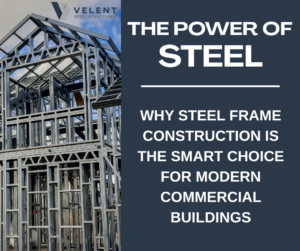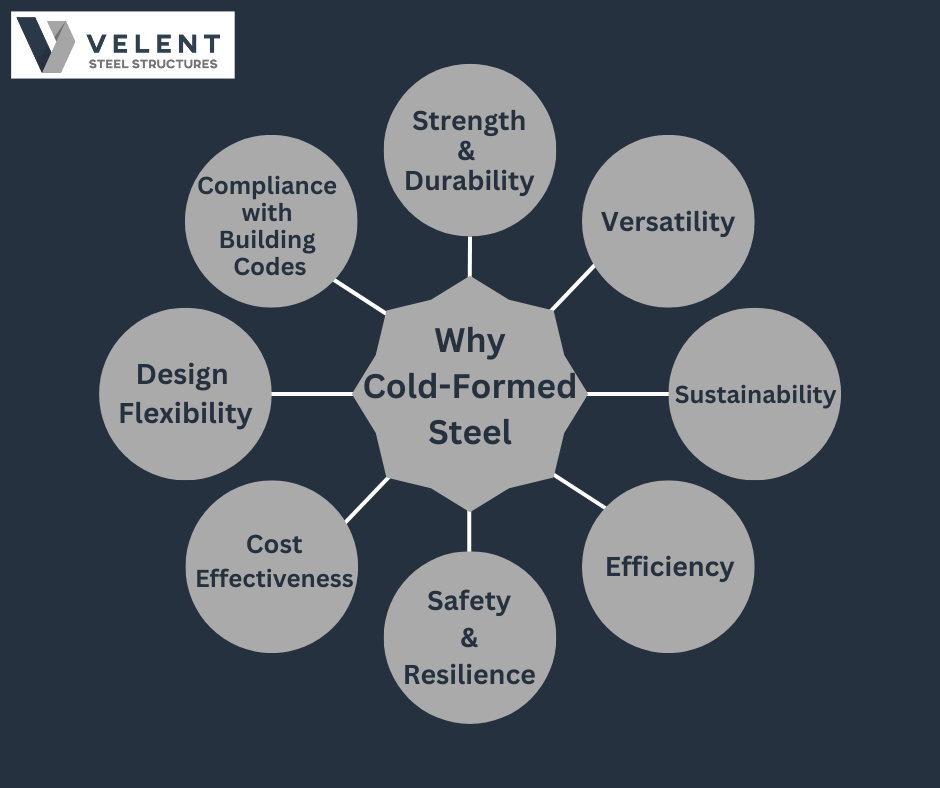In the dynamic commercial construction realm, the choice of building materials significantly influences a project’s success. Steel frame construction has emerged as a frontrunner, offering a blend of strength, efficiency, and sustainability. This article delves into the multifaceted benefits of steel framing, providing insights for developers, architects, and stakeholders aiming to optimize their commercial projects. Let’s explore not just the well-known benefits, but also the deeper reasons why steel framing is redefining the way we build.

-
Speed and Efficiency: Building Faster, Smarter
Steel frame construction offers exceptional speed and precision, thanks to its off-site prefabrication and on-site assembly. This process often reduces construction timelines by over 30%, allowing faster occupancy and a quicker return on investment. Steel’s predictability minimizes on-site errors and delays due to weather or labor shortages, making project delivery more reliable and cost-effective.
-
Strength-to-Weight Ratio: Build Tall, Build Strong
Steel’s remarkable strength-to-weight ratio empowers architects to design bold, innovative commercial spaces with wide-open spans and higher ceilings, without relying on bulky structural supports. This flexibility allows for adaptable layouts in office spaces, retail outlets, and warehouses. Light Gauge Steel Framing (LGSF), in particular, is gaining traction in multistory projects for its high load-bearing capacity and ease of use.
-
Sustainability and Circular Economy Benefits
Steel is durable and one of the most sustainable building materials available. Over 90% of structural steel in use today comes from recycled sources, and it can be recycled infinitely without losing its strength. Modern innovations, such as electric arc furnaces and green hydrogen-powered production, are further reducing its environmental footprint. Choosing steel also supports LEED certification efforts and aligns with ESG and net-zero building goals.
-
Fire Resistance: Built-In Protection
Steel’s natural fire resistance makes it a superior choice in areas where fire hazards are a concern. Unlike wood, steel doesn’t ignite or contribute to the spread of flames, enhancing occupant safety and protecting property. This inherent safety advantage often translates into lower insurance premiums and helps ensure compliance with strict building codes, especially in healthcare, hospitality, and other high-occupancy sectors.
-
Durability and Low Maintenance
One of steel’s greatest advantages is its long-term durability. It is impervious to termites, mold, mildew, and rot, and it won’t warp, crack, or split over time. This resilience ensures that steel-framed buildings can last for 50 to 100 years with minimal maintenance. Its dimensional stability also complements modern building technologies like solar panels and smart HVAC systems, enabling seamless integration and extended building performance.
-
Design Flexibility: Create Without Constraints
Steel allows for creative, open-concept architectural designs that aren’t limited by traditional materials. Wide interior spans, cantilevered features, and modular expansions are all achievable with steel. It’s also a future-proof material—easy to adapt, modify, or extend as business needs change. Whether paired with glass, timber, or concrete, steel supports innovative hybrid constructions that blend aesthetics with performance.
-
Cost Efficiency in the Long Run
Although the initial investment in steel may be higher than wood, the long-term cost benefits are undeniable. Faster project completion, minimal on-site waste, and significantly lower maintenance expenses all contribute to a stronger return on investment. Steel-framed buildings also provide excellent thermal efficiency when properly insulated, helping reduce operational energy bills and supporting sustainable building practices.
-
Seismic and Weather Resilience
Steel structures are known for their ability to withstand natural disasters, including earthquakes, hurricanes, and high winds. Thanks to their ductile nature, steel frames can bend without breaking, making them ideal for construction in risk-prone areas like seismic zones and coastal regions. As building codes become stricter in these areas, steel remains a reliable, code-compliant material of choice.
-
Better Integration with Technology and Modular Trends
With the rise of modular construction and Building Information Modeling (BIM), steel is proving to be the perfect partner for modern construction trends. Its precision-engineered components fit seamlessly into digital workflows, enabling faster, smarter, and more accurate building processes. Steel’s clean and consistent structure also makes it easier to incorporate smart systems, such as IoT sensors, solar panels, and energy-monitoring technologies, from the start.
Final Thoughts
Steel frame construction isn’t just a trend—it’s a strategic move toward faster, greener, and more resilient commercial buildings. From streamlined project delivery and energy efficiency to unmatched design freedom and sustainability, the advantages are clear.
If you’re a developer, architect, or project owner looking to future-proof your commercial buildings, steel should be at the foundation of your strategy.
Want to explore steel framing options for your next project? Connect with our team to learn how modern steel solutions can maximize your ROI while minimizing environmental impact.


